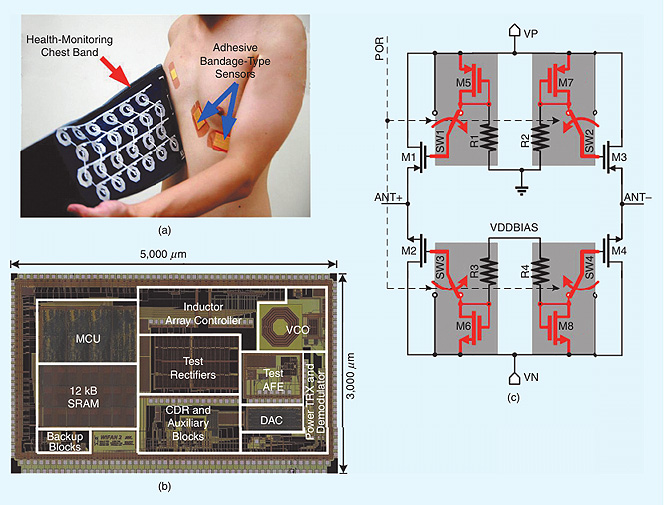Your Heart on Your Sleeve
By Hoi-Jun Yoo
NOTE: This is an overview of the entire article, which appeared in the Winter 2013 issue of the IEEE Solid-State Circuits Magazine.
Click here to read the entire article.
This article is a well-illustrated tutorial that provides some history of wearable computers and includes 4 examples of wearable Silicon-on-Chip (SoC) technology. Wearable healthcare systems are a subset of wearable computers, which have been undergoing a dramatic change recently. The author document the evolution of wearable computers from bulky devices to sensors, processors, and display devices incorporated into clothing or placed on the skin.
As the author points out, “The use of wearables for health care applications or to compensate for disabilities as well as to provide support to elderly people is increasing steadily.” After an introduction to the history of wearable computers, the article discusses interconnections for wearable devices; they can be split into wireline and wireless approaches, as well as permanent versus detachable connections. In the third section, wearable health care systems on a chip (SoCs) and systems on textiles (SoTs) are explained in connection with their appropriate applications.
Several technical advances have facilitated the advancement of wearable computers. In addition to the increasing miniaturization of electronics in general, the introduction of conducting yarns and the incorporation of circuitry screen-printed onto textiles have played key roles.
One important piece in the interconnection of wearable devices in general is the emergence of the wireless Body Area Network (BAN) relying on IEEE Standard 802.15.6. One of the initial target applications of this standard is in wearable health care. The article provides more information on the use of this standard.
Four examples of wearable systems are given:
- a self-configured, wearable BSN with high-efficiency, wirelessly powered sensors that can continuously monitor a patient’s electrocardiogram (ECG) (See figure),
- a low-power, highly sensitive, wearable SoC for cardiac patients that performs thoracic impedance variance (TIV) and ECG monitoring, implemented aspoulticelike plaster sensor,
- a wearable mental health measurement system incorporating the nonlinear analysis of physiological rhythm, including heart-rate variability (HRV) and electroencephalography (EEG) signals, and
- a compact electroacupuncture (EA) system has been proposed for multimodal feedback EA treatment as one type of wearable health care application.

Self-configured wearable BSN system.of an adaptive threshold rectifier. (a) Adhesive bandage sensors with network controller, (b) chip photograph, and (c) circuits
The article closes with the author’s thoughts on the future of wearable healthcare.
ABOUT THE AUTHOR
NOTE: A more complete bio of the author is available in the article.
Hoi-Jun Yoo received a Ph.D. degree in electrical engineering from the Korea Advanced Institute of Science and Technology (KAIST). Currently, he is a full professor in the Department of Electrical Engineering at KAIST and the director of the System Design Innovation and Application Research Center (SDIA). From 2003 to 2005, he was a full-time adviser to the Korean Ministry of Information and Communication for SoCs and next-generation computing. His current research interests are bioinspired IC design, networks on a chip, multimedia SoC design, wearable health care systems, and high-speed and low-power memory.






